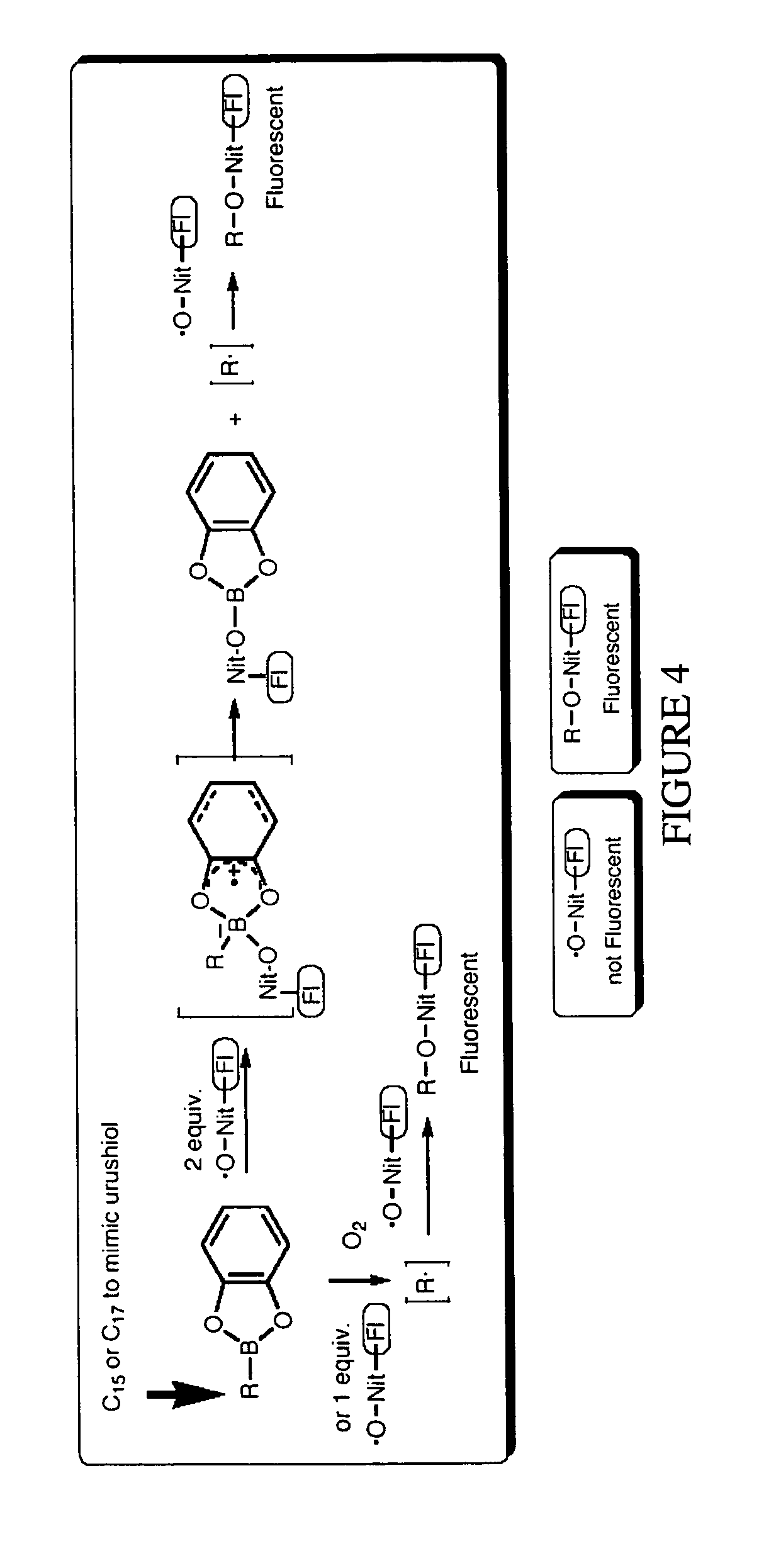Fluorescence detection of poison oak oil
a technology of fluorescence detection and poison oak oil, which is applied in the field of fluorescence detection of poison oak oil, can solve the problems of unfavorable side effects, unfavorable planning of the success of this strategy, and the death of the systemic anaphylaxis
- Summary
- Abstract
- Description
- Claims
- Application Information
AI Technical Summary
Benefits of technology
Problems solved by technology
Method used
Image
Examples
example i
Preparation and Testing of Fluorescent Compounds
[0079]We have prepared the known profluorescent nitroxide Dansyl amino-TEMPO 16. As reported, the free nitroxide quenches fluorescence; the insert of FIG. 12 shows the reaction of the nitroxide to form either the hydroxylamine 17 (vial shown) or the n-butylalkoxyamine 18 (not shown) restores the fluorescence to the naked eye upon irradiation with a long wave-length UV lamp at 366 nm. (A hand-held UV lamp typically used for viewing thin layer chromatography plates was utilized in these photographs).
[0080]As an initial model, B-n-butylcatecholborane 19 was pre-formed using Dean Stark conditions, and then allowed to react with two equivalents of TEMPO 7 (FIG. 13). The expected N-n-butyloxyamine 20 was formed as a mixture with the hydroxylamine 21, confirming the chemistry developed by Renaud. Hydroxylamine 21 is presumably formed by hydrolysis of the nitroxide boronic ester complex.
[0081]This reaction was repeated with the profluorescent ...
example ii
Fluorescence Detection of Catechol
[0082]In order to form alkylcatecholborane 13 from free catechol under ambient conditions, we initially believed it would be necessary to convert the hydroxyl groups on an alkylboronic acid to better leaving groups. However, early work by Brown indicated that alkylboronic acids react reversibly with catechol in organic, nonpolar solvents to form the desired catecholboranes. It was determined that the reaction sequence shown in FIG. 15A worked: alkylcatecholborane 19 formed from free catechol and an alkylboroinic acid in situ, and reacted with profluorescent nitroxide 16 in one pot to form 22 with a strongly fluorescent signal (FIG. 15B). This was an unexpectedly superior result.
[0083]FIG. 26 shows a successful field test of this detection system. The composition was applied onto the surface of poison oak leaves. A paper towel was applied to the surface of the leaves and the paper towel was illuminated using a UV-lamp. As shown in FIG. 26, the fluore...
example iii
Synthesis and Development of the Components of the Fluorescence-Generation Method: Optimize the Structure of the Nitroxide, Fluorophore, Tether and Alkylboronic Acid
[0085]The chemical design of the profluorescent nitroxide is explored, entailing the choice of the optimum nitroxide, fluorescent tag, and tether to prepare a robust, soluble and effective component for this detection system. As fluorescence is a very sensitive method of detection, only very small amounts need react to give a signal visible to the naked eye using an inexpensive hand-held fluorescent lamp. The six-membered ring TEMPO is by far the most common nitroxide scaffold, however there are a number of other common stable nitroxide classes. Considerations in optimization of the nitroxide structure include ease and cost of synthesis, versatility in designing and optimizing the tether between the fluorophore and the nitroxide, stability and solubility. Common stable nitroxide classes include TEMPO (tetramethylpiperidi...
PUM
| Property | Measurement | Unit |
|---|---|---|
| wavelength | aaaaa | aaaaa |
| wavelength | aaaaa | aaaaa |
| wavelength | aaaaa | aaaaa |
Abstract
Description
Claims
Application Information
 Login to View More
Login to View More - R&D Engineer
- R&D Manager
- IP Professional
- Industry Leading Data Capabilities
- Powerful AI technology
- Patent DNA Extraction
Browse by: Latest US Patents, China's latest patents, Technical Efficacy Thesaurus, Application Domain, Technology Topic, Popular Technical Reports.
© 2024 PatSnap. All rights reserved.Legal|Privacy policy|Modern Slavery Act Transparency Statement|Sitemap|About US| Contact US: help@patsnap.com










